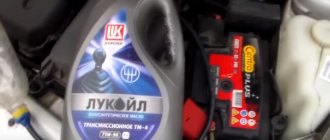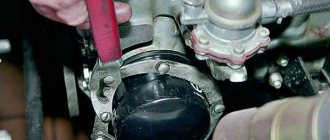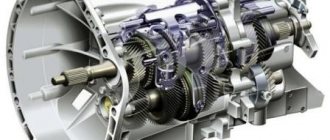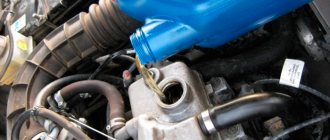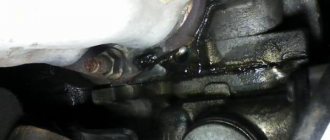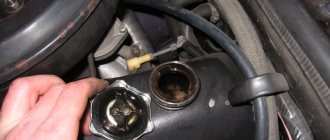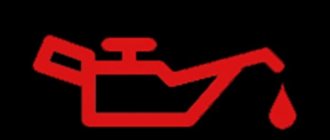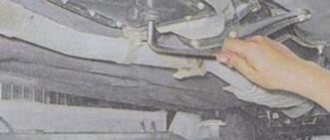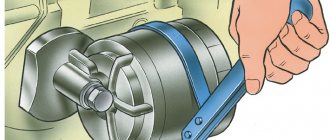Fig.3 Drain plug
To unscrew the filter element, it is advisable to have a special puller. If it is not available, you can try to unscrew the filter using improvised means. In this case, you can use, for example, an old alternator belt, a regular belt, a bicycle chain or a simple screwdriver.
Unscrewing the oil filter using improvised means
Using this method, you can drain the maximum amount of used oil, after which you can proceed to further actions. The main thing is not to forget, everything that we unscrewed must be put back in place.
Flushing the lubrication system
Flushing the engine on a Niva 21214, 21213 should only be carried out in exceptional cases, which include:
- Purchasing a used car when you cannot know about the quality, as well as the regularity of lubricant replacements.
During operation, the service replacement interval was repeatedly exceeded.
There are several types of flushes for the Niva 2121 engine:
- Five- or seven-minute, capable of cleaning even the most difficult deposits. They must be used very carefully and strictly follow the instructions printed on the packaging. It is recommended to use them only when absolutely necessary. Since there is a high probability of causing premature wear of the sealing seals. And also clog the oil channels with particles of washed away carbon deposits.
- Special compounds that are added to the oil several hundred kilometers before the expected change. They are more gentle, but there is also a possibility of clogging of the oil channels.
- Flushing oil is the most gentle method of cleaning the engine from the inside. This composition is poured after draining the waste, the engine runs for 15-20 minutes, after which the liquid with deposits is drained. The absence of aggressive additives in the wash composition gently cleans the engine, but is not able to remove heavy contaminants.
- Regular oil that you are going to use when changing. This method is not so popular due to its high price.
Installing a filter, filling in new engine fluid
If the lubrication system of the VAZ 21214, VAZ 21213 (Niva) is sealed and does not require repair work to eliminate leaks, you can proceed to adding fresh oil. In addition to the engine oil itself, sometimes, when worn, it is recommended to change the bolt closing the drain hole. The original has article number 2101-2401046. As well as the original LADA oil filter 2105-1012005-82, from the factory, it is often installed from. If you wish, you can look at analogues on the Internet.
Consumables for maintenance
When everything is ready, let's move on to the bay:
- Replace the drain plug and replace it with a new one if necessary.
- We wipe the seat under the filter.
- We tighten and put in place the new oil filter. Pre-lubricate the rubber sealing ring with fresh oil.
- Pour new oil into the filler neck.
- We check the level on the dipstick; it should be between the MIN and MAX marks.
- We start the engine, let it run for 10-15 seconds, then turn it off.
- After 5 minutes, check the level with a dipstick and top up if necessary.
Oil selection
Selecting oil for Niva 21214 is not so difficult.
But here you need to know some nuances in order to avoid common mistakes. Let's start with the time of year. Not every car owner knows what kind of oil to pour into the engine of his Niva if it’s summer or winter outside. In summer the weather is hot, so passenger car engines get very hot under such conditions. “Niva 21214” is an all-wheel drive SUV, and its engine warms up even more. That’s why many people make the same mistake, filling in mineral or semi-synthetic oil for the summer. To ensure that the engine runs efficiently and does not overheat, experts recommend using high-quality synthetics.
If the lubricating fluid in the power unit has an insignificant percentage of viscosity, you should not expect the expected effect from it. When the cylinder block heats up, such oils have a consistency similar to ordinary water and their temperature rises rapidly. Therefore, the lubricant will no longer take heat from the engine, performing a cooling function, and will also not be able to create the required pressure. Operating in this mode will lead to rapid jamming of the crankshaft.
Therefore, the manufacturer and experienced car owners themselves advise filling the Niva engine, as well as the Chevy Niva (Chevrolet) engines, with motor oils with a viscosity of 20W40, but not higher than 25W50. These are the optimal viscosity parameters at which the crankshaft can function normally and not create unnecessary load.
- very liquid (otherwise an ice film will form from the cold);
- too thick (otherwise the crankshaft will not be able to rotate when starting a cold engine).
For winter, it is better to fill the engine with oil that meets the viscosity parameters of at least 0W40 and maximum 0W50. By pouring such liquid into the engine in winter, when the temperature drops to a maximum of -40 degrees, the starter can easily cope with cranking. The viscosity is not very high, and even low temperatures will not prevent the engine from starting.
Avoid semi-synthetic oils. Yes, such mixtures can be expensive and have similar characteristics to synthetics. But even the high price and identical labels on the packaging do not allow semi-synthetics to obtain the same properties that synthetic oils have.
Regarding oil, it is recommended to pour only an original synthetic solution of class Dexton 3 or 2 into the engine of a Niva 21214 car. Lukoil brand fluid also fits this description. If the vehicle is older than 3 years, it is necessary to use synthetic fluid with additives from Liqui Molly.
Before changing the oil in the engine of a Niva 21214 car, you need to prepare the necessary tools. The driver will need:
- Hexagon R12;
- New O-ring;
- Removable oil filter;
- Empty container for draining waste, with a capacity of 4 liters;
- New fluid.
Step-by-step instructions for replacing fluid in the engine of a Niva 21214 car:
- Initially, it is necessary to warm up the oil so that it drains faster. To do this, start the engine for 10 minutes;
- then the car is driven onto an overpass;
- the pallet protection is removed;
- Next, you need to substitute the container and carefully unscrew the valve of the expansion tank;
- While the solution is flowing out of the system, you should check the gaskets and seals and, if necessary, replace them with new ones;
- Next, you should install a new oil filter;
- then the drain valve is screwed tightly and, using a watering can, new oil with a volume of 2.5 liters is poured into the system.
After this, start the engine for 10 minutes. This way the oil is evenly distributed throughout the system.
It is also worth noting that internal combustion engine fluids, which have different compositions, can harm the engine. Therefore, it is not recommended to mix mineral and synthetic oils with each other. If a mineral product was initially poured into the car engine, and the driver wants to fill it with a synthetic one, the system will need to be flushed. For this, a special tool is purchased. In turn, when the type of oil remains unchanged, cleaning the internal combustion engine is not necessary.
Changing engine oil is an essential component of proper operation of any car. Timely replacement of the working fluid and oil filter allows you to maintain the engine in optimal condition, ensuring its long-term and trouble-free operation. Therefore, the owners of this domestically produced SUV have a logical question about what kind of oil to pour into the Niva 21214 with an injector, how much is required, and how to carry out the replacement procedure yourself.
Selecting oil for Niva 21214 is not so difficult. But here you need to know some nuances in order to avoid common mistakes. Let's start with the time of year. Not every car owner knows what kind of oil to pour into the engine of his Niva if it’s summer or winter outside. In summer the weather is hot, so passenger car engines get very hot under such conditions.
“Niva 21214” is an all-wheel drive SUV, and its engine warms up even more. That’s why many people make the same mistake, filling in mineral or semi-synthetic oil for the summer. To ensure that the engine runs efficiently and does not overheat, experts recommend using high-quality synthetics.
The Niva SUV, in all modifications, is very popular in Russian spaces. This is due to good maintainability, low price and excellent maneuverability. To ensure reliable operation, you should undergo all maintenance on time, in particular, change the engine oil.
The VAZ 21214 engine lubrication system is designed to protect against premature wear of moving parts. It completely copes with its task, you just need to follow all the manufacturer’s recommendations.
Changing the engine oil is a regulated maintenance procedure, which is prescribed in the operating instructions. There is nothing complicated about it if you clearly and carefully follow the described action plan.
Our most popular engines are injection and carburetor engines, with a volume of 1.7 and 1.6 liters. The replacement process on these engines, as well as other modifications, will be the same.
To refuel and service a domestic VAZ SUV, you need to know the filling capacities of the VAZ 21213 Niva and its modifications, the VAZ 21214. Some numbers need to be known by heart, for example, the capacity of the tank and engine crankcase. The rest should be written down in a notepad, which is stored in the glove compartment of the cabin.
Every car enthusiast should know by heart the maximum fuel capacity of his car. The fuel tank of the VAZ 21213 has a capacity of 42 liters, including reserve. The reserve refers to the amount of fuel remaining in the tank after the yellow warning light on the instrument panel turns on. The reserve amount is at least 5 liters. The car must be fueled with gasoline whose octane number is in the range of 91-93.
The car has a number of refueling tanks that the owner must monitor during operation:
- brake system with expansion tank, total capacity - 0.515 l;
- hydraulic clutch drive with expansion tank - 0.2 l;
- 2 plastic tanks with a volume of 2 liters each contain a supply of windshield and rear window washer fluid.
The clutch release drive and brake system are filled with hydraulic brake fluid (the most popular is DOT-4). It should be changed at least every 3 years, because the liquid has the ability to absorb water vapor contained in the air. As a result, all steel parts of the system in contact with it begin to corrode, which leads to complete or partial failure of the brakes.
If there is a leak in the clutch or brake system, the level in the expansion tanks decreases, so constant monitoring is required over them.
Liquid or clean water for washing glass is added if necessary; in winter, a non-freezing option is required. Otherwise, the ice will not only destroy the tubes, but also damage the electric pump.
Various thick lubricants are also used for maintenance and lubrication of the Niva:
- Litol - a composition for lubricating highly loaded bearing parts;
- CV joints-4 - lubricant for the hinges of the front axle shafts and door opening limiters;
- ShRB-4 is designed for processing ball joints and steering rods.
The list of refueling containers is useful for novice car enthusiasts who bought a used car with a lost instruction manual. The operation of such a car should begin with the replacement of all fluids and oils.
The VAZ 21214 engine was conceived as the first injection engine for a domestic SUV. The Niva was not particularly popular in the USSR, but was exported to Asia, the UK, Europe, Latin America and the USA. During production since 1994, there have been several improvements and modifications of the internal combustion engine from Euro-0 to Euro-5 (export).
Also interesting: Chevrolet Niva error codes. Carrying out diagnostics.
It is believed that the basis of the ICE 21214 was the previous version 21213. In fact, ¾ of the parts in the engine
- the engine layout has changed - an injector instead of a carburetor;
- additional attachments appeared - DPKV, DXX sensor, Bosch MP 7.0 controller;
- crankshaft with a long crank radius of 40 mm, not used in previous AvtoVAZ engines;
- Cylinder head with holes for phase sensor and receiver studs, hydraulic supports for valve levers instead of adjusting bolts.
Gearbox VAZ 21214
Stages of replacing lubricant VAZ 21214
Changing the engine oil is a regulated maintenance procedure, which is prescribed in the operating instructions. There is nothing complicated about it if you clearly and carefully follow the described action plan.
The replacement operation will be the same for different modifications of the Niva car:
- VAZ 21214
- VAZ 21213
- VAZ 2121
- VAZ 2131
Our most popular engines are injection and carburetor engines, with a volume of 1.7 and 1.6 liters. The replacement process on these engines, as well as other modifications, will be the same.
Draining waste fluid
It is necessary to drain the used engine fluid when the engine is warm. This is due to the fact that heated oil is more liquid. This makes it easier for it to leak out of the thin channels of the lubrication system.
To drain old engine oil, it is advisable to drive the VAZ 21214 (Niva) onto a pit or overpass, since the drainage is done from below. If this is not possible, then the most inconvenient step will be unscrewing the drain plug. Especially if there is protection installed that will need to be removed.
When everything is ready, we proceed to the draining operation:
- Raise the hood, then find the filler neck on the engine and unscrew the cap (Fig. 1).
Fig.1 Oil filler neck - We unscrew the oil filter, which is located on the right side of the engine, on the spare wheel side. You can try to get to it from under the hood. But if the drain is made from a hole, then it will be more convenient to unscrew it from below (Fig. 2).
Fig.2 Oil filter - Now we go down under the car and place a waste container in the drainage area. You can use a cut canister or an old bucket.
- We unscrew the drain plug using a 12 hexagon, which is located in the front part of the internal combustion engine (Fig. 3). Fig. 3 Drain plug
To unscrew the filter element, it is advisable to have a special puller. If it is not available, you can try to unscrew the filter using improvised means. In this case, you can use, for example, an old alternator belt, a regular belt, a bicycle chain or a simple screwdriver.
Unscrewing the oil filter using improvised means
Using this method, you can drain the maximum amount of used oil, after which you can proceed to further actions. The main thing is not to forget, everything that we unscrewed must be put back in place.
Flushing the lubrication system
Flushing the engine on a Niva 21214, 21213 should only be carried out in exceptional cases, which include:
- Purchasing a used car when you cannot know about the quality, as well as the regularity of lubricant replacements.
- During operation, the service replacement interval was repeatedly exceeded.
- Engine operation with constant frequent overheating, which contributes to coking and other deposits.
- In cases of switching to another type, for example from synthetics to semi-synthetics.
There are several types of flushes for the Niva 2121 engine:
- Five- or seven-minute, capable of cleaning even the most difficult deposits. They must be used very carefully and strictly follow the instructions printed on the packaging. It is recommended to use them only when absolutely necessary. Since there is a high probability of causing premature wear of the sealing seals. And also clog the oil channels with particles of washed away carbon deposits.
- Special compounds that are added to the oil several hundred kilometers before the expected change. They are more gentle, but there is also a possibility of clogging of the oil channels.
- Flushing oil is the most gentle method of cleaning the engine from the inside. This composition is poured after draining the waste, the engine runs for 15-20 minutes, after which the liquid with deposits is drained. The absence of aggressive additives in the wash composition gently cleans the engine, but is not able to remove heavy contaminants.
- Regular oil that you are going to use when changing. This method is not so popular due to its high price.
Before flushing a VAZ Niva, you should weigh all the pros and cons. And also understand that it will not be possible to completely drain the liquid. Some of it will remain in the channels, which will then mix with the new oil.
Installing a filter, filling in new engine fluid
If the lubrication system of the VAZ 21214, VAZ 21213 (Niva) is sealed and does not require repair work to eliminate leaks, you can proceed to adding fresh oil. In addition to the engine oil itself, sometimes, when worn, it is recommended to change the bolt closing the drain hole. The original has article number 2101-2401046. As well as the original LADA oil filter 2105-1012005-82, from the factory, it is often installed from. If you wish, you can look at analogues on the Internet.
Consumables for maintenance
When everything is ready, let's move on to the bay:
- Replace the drain plug and replace it with a new one if necessary.
- We wipe the seat under the filter.
- We tighten and put in place the new oil filter. Pre-lubricate the rubber sealing ring with fresh oil.
- Pour new oil into the filler neck.
- We check the level on the dipstick; it should be between the MIN and MAX marks.
- We start the engine, let it run for 10-15 seconds, then turn it off.
- After 5 minutes, check the level with a dipstick and top up if necessary.
There are several opinions regarding replacing the oil filter. Many old-school owners advise filling it with new oil before installation. However, nothing is said about this in the official Lada Niva operating instructions. And also in information from global filter manufacturers it is recommended to simply lubricate the o-ring.
Replacement frequency
Oil drain
First, remove the dipstick from the filler neck, first unscrewing the plug. Then remove the mudguard that protects the motor. Place a prepared container for the old oil - it should be large enough so that all the oil goes in and you don’t spill anything. Four or five liters will be enough.
Using a 12mm hexagon, you need to unscrew the drain plug, having previously substituted the prepared container. Wait until the oil has completely drained out without any residue and you can proceed to the next task - removing the oil filter. Try to unscrew it by hand, but if you fail, use a special puller. You can also simply pierce the old filter with a screwdriver and use it as a lever.
Next, you need to pour new oil through a funnel by unscrewing the plug on the engine under the hood. In total, the engine contains 3.75 liters of oil, but first fill in only 3 liters and check the level.
LUKOIL-Lux
When asking the question of choosing the best oil to change in Niva, many motorists rely on the advice of mechanics in workshops, but we advise you to be guided by the information from the car manufacturer. The company advises adding or pouring the following brands of lubricants into the engine:
- "LUKOIL-Lux" (5W-40; 10W-40; 15W-40; SJ/CF)
- "LUKOIL-Super" (5W-30; 5W-40; 10W-40; 15W-40; SG/CD)
- "YUKOS SUPER" (5W-40; 10W-40; 15W-40; SG/CD)
- "OMSKOIL LUX" (5W-30; 5W-40; 10W-30; 10W-40; 15W-40; 20W-40; SG/CD)
- "NORSI-EXTRA" (5W-30; 10W-30; 5W-40; 10W-40; 15W-40; SG/CD)
- "YAR-Marka Super" (5W-30; 5W-40; SG/CD)
- "Novoil Synt" (5W-30; SG/CD)
- "ESSO ULTRA" (10W-40; SJ/SH/CD)
- "ESSO UNIFLO" (15W-40; SJ/SH/CD)
- "SHELL HELUX SUPER" (10W-40; SG/CD)
- "UFALYUB ARCTIC SUPER" (5W-30; 5W-40; SG/CD)
The listed products differ greatly in technical characteristics and parameters, as well as viscosity grade and temperature ranges. For example, viscosity grade 20W-40 is suitable for engine operation at temperatures from -10 to 45 degrees, and oil 5W-30 is suitable for temperatures from -25 to 20 degrees Celsius. Additionally, we recommend watching videos on how to change the oil on a VAZ 2121 with your own hands.
If you look at the official manual from the automaker represented by AvtoVAZ, you will see numbers there of 10 thousand kilometers. That is, the plant advises changing the working fluid in the power unit at least once every 10 thousand km. But you, as an experienced or novice car owner, must understand that the calculation is made based on average values.
- dirt and dust on roads;
- hilly terrain, bad roads;
- operation under constant loads (cargo transportation, driving with a trailer);
- use of cheap types of oils;
- low quality fuel;
- aggressive driving style;
- sudden climate changes, etc.
Because of this, the actual frequency of oil changes in the Niva is reduced by approximately 2 times compared to the recommended one; the consumable should be changed approximately every 5–6 thousand kilometers or once a year. Start from what comes first. This is the optimal period of time, since the oil is already beginning to wear out, but does not completely lose its physical and chemical properties.
The situation is similar with the oil filter. A standard filter element allows it to be used for 10 - 12 thousand kilometers. But the filter suffers from the same negative factors as the oil itself, since they are closely related. In theory, it can withstand 2 oil changes, but from the standpoint of engine safety, it is better to change the filter itself at each lubricant change. It's not that expensive.
The service book states that the oil in the transfer case, gearbox and axles should be changed at the first, fourth and eighth maintenance. This corresponds to mileage of 2000, 45,000 and 105,000 km. After this, the transmission is changed every 45,000 km.
The frequency of replacement is not related to seasonality. The transmission does not need to be changed on the eve of summer or winter.
Lubricants consist of a base (base) and additives. Their chemical and physical properties depend on the composition and origin of these components.
According to the method of manufacturing the base, the transmission is divided into three types:
- Mineral is a product remaining after the distillation of oil in the production of diesel fuel and gasoline. Includes heavy fractions of hydrocarbons and contains large amounts of sulfur. Its properties are determined by naphthenes, aromatics and paraffins. The oil entering oil refineries differs in its composition. This does not allow achieving stable mixture proportions. Therefore, the final parameters are adjusted with additives. Under the influence of temperature, heavy fractions of hydrocarbons disintegrate, and additives oxidize and lose their properties. This oil has to be changed more often. Another disadvantage of “mineral water” is that oxidation products settle on parts.
- The synthetic base is artificially created from the desired hydrocarbons. Thanks to this, it is possible to obtain a product with predictable viscosity values without the use of additives. Additives are used only to improve the lubricating and antioxidant properties of the transmission.
- Semi-synthetic oils are created on the basis of a mixture of mineral and synthetic bases (at least 30% of the latter is used). This approach allows you to reduce the number of additives that change viscosity.
Synthetic gear oil differs from mineral and semi-synthetic oil in that its viscosity changes less with temperature changes. This reduces wear on transmission parts during winter operation of the Chevrolet Niva. But “synthetics”, due to their greater fluidity, seep through worn gearbox seals more easily.
However, the main characteristic of a lubricant is viscosity. This is what is indicated in the operating instructions. The manufacturing company recommends filling in the following types of gear oils (according to SAE):
- Transfer case and gearbox - 75W-90, 80W-85, 80W-90.
- Drive axles (front and rear) - 80W-90, 85W90.
Therefore, API GL4 and GL4/GL5 must be poured into the gearbox (gearbox), and GL4/GL5 and GL5 into the axles and transfer case.
There are dozens of gear oil brands on the market. The most famous imported ones are Castrol, Liqui Moly, Mobile, Shell, and the most famous domestic ones are Lukoil and Rosneft.
Prices for a liter bottle start from 400 rubles.
The Lukoil company is the official partner of AvtoVAZ. It is this brand of semi-synthetics that is poured into the transmission during the production of the Chevy Niva.
According to the manufacturer's regulations, service replacements of engine oil for Niva 2121 and other modifications are carried out after 10,000 kilometers or at intervals of 1 year. But some car owners consider this interval to be a little too high, recommending that it be shortened taking into account operating conditions.
At the factory, Niva models are filled with oil from different suppliers. Most often this is Petro-Canada Supreme 10W-40 or Lukoil Genesis Advanced 10W-40. But for accurate information about what is poured into your car from the factory, you should contact the feedback system of AVTOVAZ PJSC. When applying, you must indicate the year and month of manufacture of the car.
Products from other manufacturers can be used as lubricating fluid. When choosing, it is recommended to pay attention to semi-synthetics with a viscosity of 10W-40. The following motor oils are most popular among model owners:
- Lada Professional 10W-40
- Shell Helix HX7 10W-40
- Total Quartz 7000 10W-40
When using this car in winter, you should select oil taking into account the climate zone, as well as the recommendations of AvtoVAZ. Viscosity 5W-40 will allow you to operate the car down to -30°C, and 0W-40 up to -35°C.
What oil to use for the VAZ 21213 Niva engine
Original
The manufacturer of the VAZ-2123 SUV recommends Lukoil Lux 10W-30 or 10W-30 mineral motor oil. You can also fill in semi-synthetics. Viscosity is selected depending on temperature conditions. For example, for year-round use, a viscosity of 10W-40, 10W-30 or 5W-40 is suitable. In summer, you can choose 20W-40 or 25W-50, and mainly in cold weather, winter oil 0W-30, 0W-40 or 5W-30 is suitable.
Unoriginal
Owners of VAZ-VAZ-21213 cars prefer inexpensive motor oils from domestic brands Lukoil, Rosneft, G-Energy and Gazpromneft. You can also opt for higher quality imported products. When choosing a suitable oil, it is necessary to take into account the API approval, which is selected depending on the year of manufacture of the car, as well as the type of internal combustion engine. For example, for a gasoline VAZ-21213 produced in 1994. All-season mineral oil with a viscosity of 15W-20 and API-SG approval is suitable. For cars of later years (for example, 1996), you can use 5W-30 API-SG mineral water, which is also suitable for the cold season. Below are the best options for analogue motor oils for the VAZ-21213.
What will you need for the job?
Screwing in the filter
Changing the oil on a Niva, as on other cars, can be done using special equipment using a vacuum method. The advantages of the technology include saving time, but there are also disadvantages. First of all, in this case it is impossible to drain all the oil without leaving a residue. In addition, sediment always collects in the oil pan, which cannot be sucked out with a vacuum.
Also interesting: Design of the injection engine Niva 2121, Niva 2131
Therefore, if this express method can be used, it should not be used every time, but rather alternated with the traditional draining of the oil, which we will discuss in more detail below. In the service book for the Niva you can find instructions for draining the oil, but they are not detailed enough.
Niva oil filter
- container for draining used oil;
- box spanner for pan bolts;
- flashlight;
- hexagon for drain plug;
- special oil filter puller or screwdriver.
The car must be lifted on a lift or jacks, or driven onto an overpass. Jacks are not the most convenient option, but if there is no choice, nothing can be done.
What to consider when choosing a replacement interval?
We recommend reading the car manufacturer's recommendations and finding out what they say about changing the oil. It is important to take into account that engineers from the factory take average indicators of the operating conditions of the vehicle as a basis. These conditions may differ due to a number of factors:
- air pollution;
- quality of fuel used;
- temperature changes, etc.
This issue is very relevant for all-wheel drive vehicles, which are usually operated in harsh conditions. So, how often should you change the oil in a Niva engine yourself, you need to determine taking into account a number of features:
- According to the service book, the oil in the VAZ 2121 must be changed every 20 thousand kilometers or every 12 months.
- An oil suitable for urban conditions may not be suitable for operating a car in rural areas. There is no universal formula. It is important for the manufacturer that the car sold works properly while it is under warranty.
- Automakers sometimes use too long fluid change intervals to attract new customers. Oils labeled longlife, which have a resource of several tens of thousands of kilometers, are a real scam.
Replacement instructions
It would be logical to find out how much oil is in the VAZ Niva 21214 engine and how much motor fluid is required to purchase. If we talk about the volume of liquid being filled, then for the Niva engine it is 3.75 liters. The actual volume of oil in the engine is usually less than that indicated in the vehicle's data sheet.
This is due to the fact that when draining the waste, some of the oil still remains in the system. It is almost impossible to clean the engine 100% on your own. You should take plenty of oil, but not much. It is better to take a 5 liter canister of high-quality lubricant. This will allow you to fill the full volume into the crankcase, plus periodically add it as the level changes.
To work, you will need to collect some materials and tools. This list includes:
- fresh motor oil in the right quantity;
- an empty container where the waste will be drained;
- funnel for filling;
- fuel filter;
- 12mm hex or 17mm wrench;
- puller for the oil filter (you can do without it);
- inspection hole;
- rags;
- lighting;
- overalls (gloves, closed shoes, thick clothing).
If you have everything ready, you can start working. Be sure to follow the instructions step by step, do not rush and do not try to unscrew or tighten anything by applying great force. Otherwise, you risk breaking some parts, which will lead to more expensive repairs. We begin the procedure for changing the engine oil, changing the filter at the same time.
- Place the car on an inspection hole to have easy access to the bottom where the oil pan is located. The engine should be warmed up first so that the oil acquires a more liquid structure and can easily drain from the sump.
- If you warmed up the engine at idle, wait a few minutes so that all the liquid drains down. You can still unscrew the filler plug in the engine compartment. This will allow the oil to come out from below faster.
- Carefully unscrew the drain plug. It comes in different types, so you will need a hexagon or wrench to dismantle it. Before you begin to unscrew the cap, place an empty container under it. Unscrew completely and let the oil drain. This will take about 10 – 15 minutes. Therefore, at the same time, work on the oil filter.
- If the oil comes out very dirty, then a lot of debris, chips and dirt will remain in the system. In this condition, it is recommended to flush the engine. To do this, use special additives, flushing mixtures or fresh oil.
- There are additives that you simply add to the filler neck while the old grease is still there, start the engine and let it run for a few minutes. Then they are jammed and everything is removed from the pan.
- The option with flushing oil or regular fresh engine oil looks different. First, the old fluid is drained, then the drain plug is closed, fresh oil is added, the engine is turned on and it runs at idle speed for 5 - 10 minutes. Now the pan plug is unscrewed again and drained. If the engine is heavily dirty, it is recommended to repeat the procedure 2–3 times. This takes a lot of oil, but it gives the engine new life.
- Only after complete washing is the old filter removed and a new one installed in its place. The filter is unscrewed with a puller, manually or with an improvised tool. The puller is the most convenient, but is not always available to the car owner. Be careful not to damage adjacent pipes and wiring. For safety reasons, it is better to remove the negative terminal from the battery.
- Clean the holes for the drain plug and the filter if there is dirt there. Otherwise, they may get into the fresh motor fluid.
- Before reinstallation, check the plug gasket and replace it if necessary. The filter seal is lubricated with oil, and engine fluid is filled to 50% of the volume of the new filter. Now you can install them in place.
- Make sure that the filter and plug are firmly in place and that there are no leaks through them.
- We move on to the engine compartment, where we use a funnel to pour fresh composition through the filler neck. Fill in about 3.5 liters first, since some of the oil remains in the system. Close the lid and run the engine at idle speed for 2 - 3 minutes.
- Turn off the engine and let the oil drain. Take the dipstick and check the level. A trace of the oil film should remain between o and “Max”. If the level is closer to the minimum value, open the lid again, add a little more lubricant and repeat the procedure.
When you start the car, the oil pressure light will come on. It's not scary, it always happens. The indicator will go out after a few seconds. Over the next few days, monitor how your Niva behaves. Check under the car for traces of fresh oil. Leaks may occur due to a poorly installed filter or drain plug. Tighten the connections and recheck the level.
Owners of the VAZ Niva 21214 car are advised to periodically monitor the oil level, add it as needed and react promptly if the liquid suddenly changes color, becomes cloudy, its consumption increases or the engine overheats. Signs like these indicate more than just a leak.
It would be logical to find out how much oil is in the VAZ Niva 21214 engine and how much motor fluid is required to purchase. If we talk about the volume of liquid being filled, then for the Niva engine it is 3.75 liters. The actual volume of oil in the engine is usually less than that indicated in the vehicle's data sheet.
This is due to the fact that when draining the waste, some of the oil still remains in the system. It is almost impossible to clean the engine 100% on your own. You should take plenty of oil, but not much. It is better to take a 5 liter canister of high-quality lubricant. This will allow you to fill the full volume into the crankcase, plus periodically add it as the level changes.
- Place the car on an inspection hole to have easy access to the bottom where the oil pan is located. The engine should be warmed up first so that the oil acquires a more liquid structure and can easily drain from the sump.
- If you warmed up the engine at idle, wait a few minutes so that all the liquid drains down. You can still unscrew the filler plug in the engine compartment. This will allow the oil to come out from below faster.
- Carefully unscrew the drain plug. It comes in different types, so you will need a hexagon or wrench to dismantle it. Before you begin to unscrew the cap, place an empty container under it. Unscrew completely and let the oil drain. This will take about 10 – 15 minutes. Therefore, at the same time, work on the oil filter.
- If the oil comes out very dirty, then a lot of debris, chips and dirt will remain in the system. In this condition, it is recommended to flush the engine. To do this, use special additives, flushing mixtures or fresh oil.
- There are additives that you simply add to the filler neck while the old grease is still there, start the engine and let it run for a few minutes. Then they are jammed and everything is removed from the pan.
- The option with flushing oil or regular fresh engine oil looks different. First, the old fluid is drained, then the drain plug is closed, fresh oil is added, the engine is turned on and it runs at idle speed for 5 - 10 minutes. Now the pan plug is unscrewed again and drained. If the engine is heavily dirty, it is recommended to repeat the procedure 2–3 times. This takes a lot of oil, but it gives the engine new life.
- Only after complete washing is the old filter removed and a new one installed in its place. The filter is unscrewed with a puller, manually or with an improvised tool. The puller is the most convenient, but is not always available to the car owner. Be careful not to damage adjacent pipes and wiring. For safety reasons, it is better to remove the negative terminal from the battery.
- Clean the holes for the drain plug and the filter if there is dirt there. Otherwise, they may get into the fresh motor fluid.
- Before reinstallation, check the plug gasket and replace it if necessary. The filter seal is lubricated with oil, and engine fluid is filled to 50% of the volume of the new filter. Now you can install them in place.
- Make sure that the filter and plug are firmly in place and that there are no leaks through them.
- We move on to the engine compartment, where we use a funnel to pour fresh composition through the filler neck. Fill in about 3.5 liters first, since some of the oil remains in the system. Close the lid and run the engine at idle speed for 2 - 3 minutes.
- Turn off the engine and let the oil drain. Take the dipstick and check the level. A trace of the oil film should remain between o and “Max”. If the level is closer to the minimum value, open the lid again, add a little more lubricant and repeat the procedure.
Also interesting: Do-it-yourself Niva tuning
Checking the oil level
Start the engine and run it for a while until the low pressure warning light goes out. After this, pull out the dipstick and see what level the oil is at. The dipstick has min and max marks. Check to see if anything is leaking anywhere. In this case, you will need to tighten the drain plug and oil filter more. If necessary, add oil to the maximum mark, but not higher.
If the car is old or you haven’t changed the oil for a long time, we recommend flushing the system before adding new fluid. This also has to be done after a major engine overhaul. To flush, you will need a special liquid or a canister of regular oil, which will need to be drained almost immediately, and then filled with fresh lubricant.
About Longlife motor oils
Some motorists believe the assurances of store salespeople that Longlife oils are excellent lubricants, but they have certain features that complicate everything a little.
You should not assume that changing the oil in Niva with Longlife will save you money and extend the life of the engine. Such oil should be used only in cases where the manufacturer has certified it for a specific unit and when the modes of use of the engine and oil coincide.
In the cities of our country, no one washes city streets in the morning, as happens in European countries. Consequently, the harsh operating conditions of the engine force you to change the oil in the VAZ 21214 more often.
Experienced motorists advise dividing the replacement interval recommended by the manufacturer in half and performing work every 10 thousand kilometers.
Leaks and problems
The higher the mileage of the VAZ Niva, the more problems appear, as in principle with any car. Most often this is due to natural wear and tear of the engine, causing oil to burn. Although the manufacturer allows for a small consumption.
There can be many reasons why an engine eats oil. And in each case they can be individual. But, over the years of the model’s existence, we can talk about the most common places where leaks occur.
If the breather is spewing or throwing oil, or if there is oil in the exhaust manifold, this may indicate a serious problem with the oil rings. In this case, you can try decoking with dimexide. But it is better to use special auto chemicals designed for these purposes.
A leak from under the valve cover may be due to a worn gasket. Sometimes simply replacing the gasket does not solve the problem. Since the cover itself may have significant curvature. Therefore, in some cases it will have to be replaced.
A white emulsion in the engine or on the oil filler cap may indicate condensation. This is a common occurrence when temperatures change from minus to plus, mainly in autumn or spring.
But if the emulsion is also observed on the dipstick, then this is already a sign of more serious problems. Most often we can talk about a broken cylinder block gasket. And in rare cases, a cracked cylinder head may be to blame.
Also, with this problem, you can find oil in the expansion tank. Sometimes, simply replacing the gasket is not enough. It may be necessary to grind the head itself, and this is completely different money for repairs.
All this is general information, which may manifest itself differently on each specific vehicle, since everyone’s operating modes are different. The same applies to leak locations; it is impossible to identify the cause from a distance.
Power unit
The engine installed on the modern model of the Niva 21213 (214) car was inherited from its Soviet progenitor - the VAZ 2121, and in terms of fluid volumes they are almost identical:
- Liquid cooling system. Filled with antifreeze in an amount of 10.7 liters with a freezing point not higher than -40 ° C. The capacity of the interior heating radiator is also included in this volume.
- Crankcase. Motor oils are poured here, the brand of which depends on the operating conditions. Capacity: 3.75 liters, including oil filter filling.
| Lower limit of ambient temperature, °C | -20 | -25 | -25 | -30 | -30 | -15 | -35 | -30 |
| Upper limit of ambient temperature, °C | 45 | 35 | 45 | 35 | 45 | 45 | 25 | 30 |
| SAE lubricant viscosity grade | 15W-40 | 10W-30 | 10W-40 | 5W-30 | 5W-40 | 20W-40 | 0W-30 | 0W-40 |
When flushing the power unit during the process of replacing liquid lubricant, the same amount of flushing oil (3.75 l) is used, taking into account the size of the filter. Replacement is carried out after 8-12 thousand kilometers, depending on the quality of the oil. Flushing is usually performed after 3 engine lubricant changes. During operation, it is important to monitor the oil level in the engine crankcase using a special dipstick. If the level drops below the Min mark, it is urgent to add lubricant to the engine of the same viscosity as was previously filled.
Antifreeze needs to be updated at least once every 3 years or according to the degree of wear of the fluid. It is not recommended to dilute antifreeze with distilled water, either in winter or summer. In winter, the diluted liquid may freeze, and during the summer heat it may boil ahead of time, which will lead to overheating of the engine.
Model description
For the domestic market, the appearance of an all-terrain vehicle was a real breakthrough.
The VAZ-21214 model, which later received the name “Lada 4×4”, and is popularly called “Niva”, is a modification of the VAZ-2121 car. This four-seater passenger car, with increased cross-country ability, belongs to the class of SUVs. It is equipped with all-wheel drive, a five-speed gearbox, a transfer case, a locked center differential, has fairly good ground clearance (22 cm), a short wheelbase and small body overhangs.
The car is capable of accelerating to a speed of 142 km/h, fuel consumption (AI-92) is 10.8 l/100 km (combined cycle).
The Lada injection power unit has:
- power 80 hp;
- four cylinders (two valves each);
- volume 1.7 l;
- torque 127.5 Nm at 5200 rpm;
- distributed fuel injection (electronically controlled).
Over the years, the engine has been modernized to Euro standards. So, since 2011, it began to comply with Euro-4 toxicity standards (models for the foreign market - Euro-5).
The guaranteed resource of the power unit is 80 thousand km, but usually up to 150 thousand km major repairs are not required.
Changing oil in transmission units
The Niva 4x4 transmission system has the following filling volumes:
- transfer case - 0.79 l;
- gearbox - 1.6 l;
- rear axle - gearbox - 1.3 l;
- front axle - crankcase - 1.15 l;
- steering column - crankcase - 0.18-0.2 l.
| Lower limit of ambient temperature, °C | -15 | -25 | -25 | -30 | -40 |
| Upper limit of ambient temperature, °C | 45 | 45 | 35 | 45 | 35 |
| SAE lubricant viscosity grade | 85W-90 | 80W-90 | 80W-85 | 75W-90 | 75W-80 75W-85 |
As stated in the operating instructions, transmission lubricants need to be changed once every 30 thousand km. mileage At the same time, replacement is not provided for in the steering mechanism housing, only an addition through the top plug. The “native” oil for Zhiguli transmission units is considered to be TAD17I.
Transmission oils have good penetrating ability. Therefore, poorly clamped plugs and worn gaskets of units begin to gradually leak lubricant. In such situations, it is allowed to add oil of the same viscosity class and, preferably, the same manufacturer. If you do not top up during a leak, the lubricant level in the unit will decrease, which will lead to accelerated wear of expensive mechanisms.
Before starting work, you need to stock up on a sufficient amount of transmission.
Each of the units holds the corresponding volume:
- Gearbox - 1.6 l;
- Transfer case - 0.79 l;
- The front and rear axles are 1.15 and 1.3 liters, respectively.
You can immediately buy 5 liters of 80W-90 transmission that meets the GL4/GL5 quality standard. It is suitable for all transmission units.
It is also necessary to stock up on flushing oil, which allows you to get rid of oxidation products and decomposition of lubricant components.
